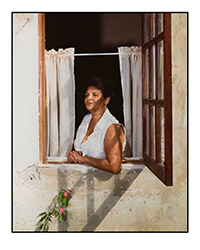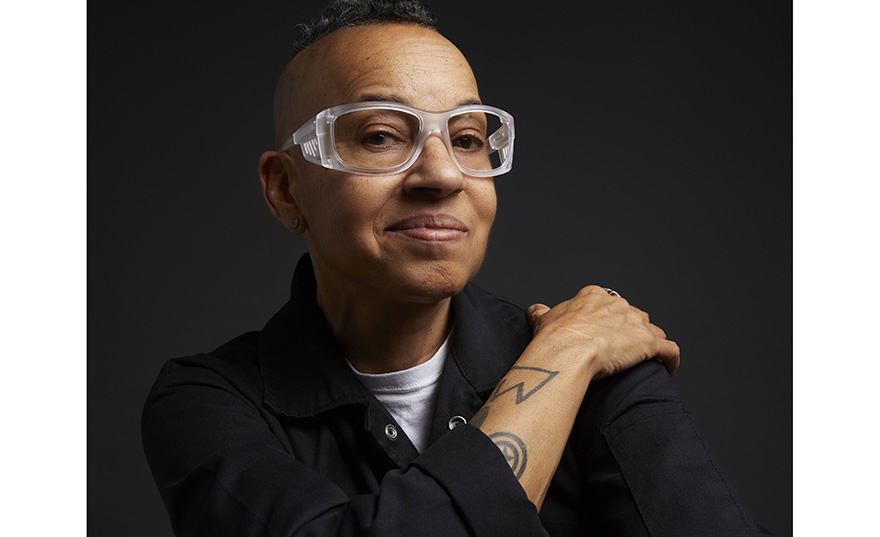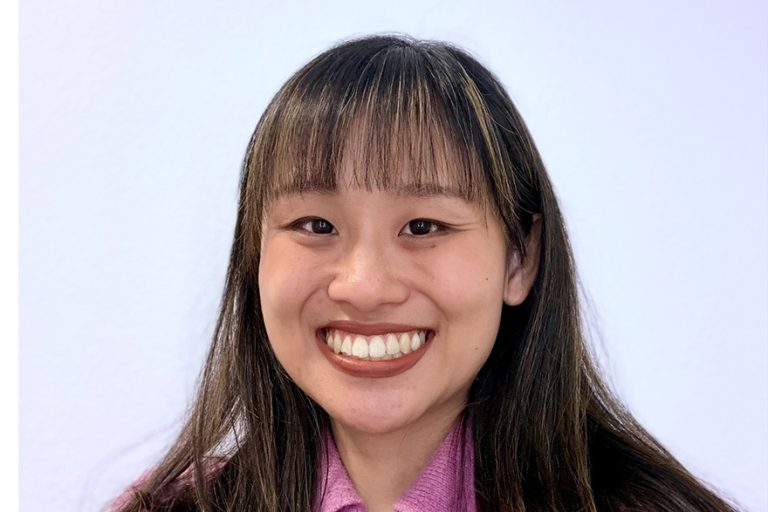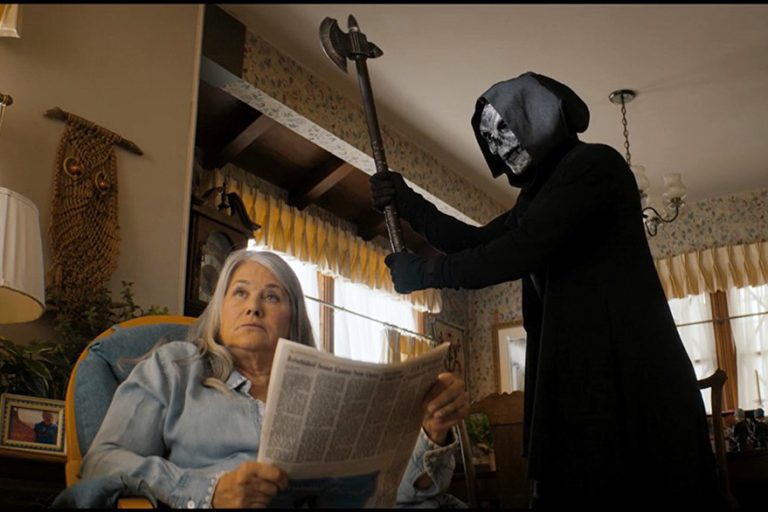Lola Flash (they/them) is a portrait photographer whose work is at the forefront of gender queer politics. Born and raised in Montclair, New Jersey, they became interested in photography at a young age. The award- winning photographer is dedicated to preserving LGBTQIA+ and communities of color worldwide.
Their work is in the permanent collections of Museum of Modern Art and the National Museum of African American History and Culture. Flash’s book, Believable: The Portraits of Lola Flash, (2023) was named one of the best photo books of the year by Smithsonian.
Senior Planet recently spoke with the 65 year-old Manhattan based photographer.
Early Life
SP: How did you get interested in photography?
LF: My mom’s boyfriend gave me a Minox- it was like a toy. That was the beginning of my framing the world. In high school I got a 35 mm and I took photos of my friends. My mother bought me a dark room and this made me realize photography was going to be my life. First, I wanted to be a scientific photographer and shoot through a microscope. But when I got to college, I decided I wanted to be a fine arts photographer and make images about identity.
SP: What motivated you to document the queer community and take pictures of LGBTQ people?
LF: I never thought of myself as a documentarian. It’s about the love of my community, about changing bias. I am pushing the limits by making images of those often deemed invisible. That’s the power of photography.
My idea of beauty is not always shown in the media or in museums. Today we do have more visibility and I think I may have been a part of that. But there are still societal norms about what men and women should be.
SP: Your early work is very political – meshing social justice into your art. Did that start when you got involved with ACT UP?
LF: You can’t be Black without being political. Same with being gay. Just kissing your girlfriend is political. ACT UP was a pivotal time in my life. I was too young to participate in the civil rights movement. ACT UP gave me the chance to put my body on the streets and to photograph. I went with the flow of the demonstration, sometimes I was a photographer, sometimes I was a demonstrator. I have always felt like I was an activist, like Angela Davis.
The AIDS crisis brought us together as a family. That was a time when guys and girls started working together. It galvanized us. The year I graduated college in 1981 was the first year someone was diagnosed with AIDS. I felt like I had to do this work. I vowed never to take a beautiful picture-like a flower- until the AIDS crisis was over.
Artistic Development
SP: Was that the time period when you developed your style of Cross Colour?
LF: A lot of the work I did around AIDS is in that style of flipping ideas around color. I created cross colour images for 20 years. By flipping the colors, I flipped the narrative. Then in 2000, I started doing “normal” color portraits. Each series has its own theme, like race or age.
SP: Could you talk about the satisfaction you get from doing this work?
LF: I only photograph people who have a good spirit. I like to acknowledge people who have a good heart, people who are proud to be gay or seasoned or Black.
My mom and dad were both teachers. I love that I can teach through my work. When I get a new acquisition from a museum, I feel blessed to be validated as a Black lesbian. And I also felt validated when Ruth Pointer (of the Pointer Sisters) told me she was proud of my work, and thankful that she is part of my SALT series.
SP: What is the SALT project? What led you to photograph women over 70?
 LF: I feel like I’m sociologist behind a 4×5 format camera. I’m aware that photography is a colonial tool and I’m changing the way it’s used.
LF: I feel like I’m sociologist behind a 4×5 format camera. I’m aware that photography is a colonial tool and I’m changing the way it’s used.
This series is an homage to my mom and my grandmother. I never took a professional photo of them, so this is a tribute. Older women deal with being looked down upon in the US but these women know my thing is beauty and that Lola thinks they are beautiful. They look so regal and proud.
 I decided to photograph older women in their homes to show the fabric of their lives. They can pick the kitchen or the mantle- it’s a collaboration.
I decided to photograph older women in their homes to show the fabric of their lives. They can pick the kitchen or the mantle- it’s a collaboration.
I’m going to keep working on this series until I’m 70. Then I will take a self-portrait and it’s over.
SP: How do you define aging with attitude?
LF: It’s the way I dress, the way I talk. When I was teaching at a high school in Brooklyn, I loved the energy of the teens and their music. It’s important to have a variety of friends- straight friends, trans friends, white friends, Asian friends, etc. I love swimming at the pool with my dear older women friends We need to check in and share with all kinds of people on this planet.
Photo credit for head shot of Flash: Christa Holka.
Photo credit for Insets
Inset Left photo of Ruth: Lola Flash
Inset right photo of Maria: Lola Flash.

Kate Walter is the author of two memoirs: Behind the Mask: Living Alone in the Epicenter; and Looking for a Kiss: A Chronicle of Downtown Heartbreak and Healing. Her essays and opinion pieces have appeared in The New York Times, Newsday, New York Daily News, AM-NY, Next Avenue, The Advocate, The Village Sun and other outlets. She taught writing at CUNY and NYU for three decades and now works as a writing coach.
Photo of Kate Walter by Su Zen





COMMENTS
2 responses to “Behind the Lens with Lola Flash”
I’m a photographer enthusiast and I would like to see Lola’s photos related to seniors but my Google search didn’t result in anything. Can you ask her to post a link to this of these pictures to this article?
thanks the link has been added. It’s also here.
Sign Up for Newsletters
There’s always a lot going on in the Senior Planet universe. Get our newsletters to make sure you never miss a thing!
Sign Up Now
Join Senior Planet Community
Senior Planet Community is our social media platform designed specifically for older adult users. Engage in thought-provoking discussions, make new friends, and share resources all on a safe and ad-free platform.
Join the Conversation Today
Upcoming Online Classes
Calendar of Events
Start your week off right with a preview of the week's upcoming programs and a guided meditation session!
Start your day with a short morning stretch!
Registration required.
Where can you find cute pets, news, how-to videos, and more? YouTube, of course! Join us for an intro to YouTube.
Learn how the Nextdoor app can help you connect to neighbors and stay in the know in your neighborhood.
Get your heart pumping during this fun, high-energy workout!
This program is cancelled.
Start your day with a short morning stretch!
Like to know what's happening? Come learn about X (formerly Twitter)!
Ready to get your business noticed online? From SEO to five-star reviews, discover practical strategies to put your business on the digital map!
Follow various cues to develop body alignment and breath awareness.
Start your day with a short morning stretch!
Learn about platforms that make website building a breeze!
Are you paying for TV channels you don't watch? Learn why people are "cutting the cord" and using streaming services instead!
Learn what Podcasts are and where to find them!
Make money while decluttering with online marketplaces!
Start your week off right with a preview of the week's upcoming programs and a guided meditation session!
Start your day with a short morning stretch!
Registration required.
Ready to ditch the filling cabinet and store your documents virtually? Join this lecture on Digital Vaults to learn how!
Tired of juggling paperwork, deadlines, and day-to-day chaos? Discover the user-friendly software tools that can bring clarity, control, and peace of mind to your business.
Make money while decluttering with online marketplaces!
Activate the joints and muscles and increase mental focus during this exercise class.
Start your day with a short morning stretch!
Tour world famous museums from the comfort of your home!
Registration required.
Come learn about QR codes, augmented reality apps, and more!
Want to use AI on your phone? Come explore Google Gemini’s mobile features, from drafting messages to managing privacy.
Start your day with a short morning stretch!
Will your digital content and social media pages live on forever? Come learn about your digital legacy options!
Join Senior Planet and our tour guides from Discover Live for a virtual visit to Croatia!
Can you photoshop that? Come learn the possibilities with photo editing tools!
Get your heart pumping during this fun, high-energy workout!
Activate the joints and muscles to become limber and increase balance during this exercise class.
Start your day with a short morning stretch!
Concerned about viruses and malware? Attend this lecture to learn how to keep your device safe!
Don't want to pay for software? Learn how Google's free tools have you covered.
Curious about your family's history? Fill in the gaps using digital genealogy resources!
Start your day with a short morning stretch!
Be your own DJ with help from Spotify.
¡Venga a chatear con ChatGPT y aprenda sobre IA!
Relax your mind and strengthen your body with this gentle exercise class.
Learn how to stay safe while you surf the web!
Join this session for a fun workout that will boost your strength, flexibility, and mobility!
Need a vacation? Learn about popular websites and apps for booking vacation rentals.
Be your own travel agent with help from these online travel sites!
Leave the dictionary at home and start using digital tools that can translate on the go.
Start your week off right with a preview of the week's upcoming programs and a guided meditation session!
Start your day with a short morning stretch!
Learn tips and tricks to using your smartphone while staying safe!
Registration required.
A simple plan is better than no plan! Get to know a few free and low-cost resources that make it simple to plan your estate.
Interested in taking your cash only business into the digital age? Learn what digital payments are and how to choose among them in this lecture!
Activate the joints and muscles and increase mental focus during this exercise class.
Start your day with a short morning stretch!
Learn about platforms that make website building a breeze!
Don't want to go out? Learn about some popular apps to get food delivered to your front door.
Registration required.
Curious about AI? Come learn the basics, including how it works and considerations to keep in mind.
Start your day with a short morning stretch!
Don't overpay for internet. Learn about programs offering low-cost home internet that can help save you money.
Registration required.
Where can you find cute pets, news, how-to videos, and more? YouTube, of course! Join us for an intro to YouTube.
Learn what Podcasts are and where to find them!
Get your heart pumping during this fun, high-energy workout!
Activate the joints and muscles to become limber and increase balance during this exercise class.
Start your day with a short morning stretch!
Registration required.
Are you scam savvy? Come to this lecture to learn about fraud and scams and how to protect yourself against them.
Explore ways that tech can help you save money and manage your finances!
Learn how the Nextdoor app can help you connect to neighbors and stay in the know in your neighborhood.
Start your day with a short morning stretch!
See who you are talking to with video chat apps!
Aprenda cómo aprovechar al máximo ChatGPT y otros software de IA.
Relax your mind and strengthen your body with this gentle exercise class.
Registration required.
Goodbye floppy discs and USB drives! Learn about cloud storage options that save your files remotely.
Activate the joints and muscles and increase mental focus during this exercise class.
Start your day with a short morning stretch!
Registration required.
Make money while decluttering with online marketplaces!
Discover what you can do with online and mobile banking!
Learn how to make the most out of ChatGPT and other AI software.
Start your day with a short morning stretch!
No car? No problem! Use these apps to help you get around!
Who are Alexa and Siri? Come to this lecture to find out!
Will your digital content and social media pages live on forever? Come learn about your digital legacy options!
Get your heart pumping during this fun, high-energy workout!
Activate the joints and muscles to become limber and increase balance during this exercise class.
Start your day with a short morning stretch!
Say cheese! Learn more about your smartphone's camera.
Registration required.
Faster is not always better! Come learn about home internet options so you only pay for what you need.
Still paying for texting? Use these free apps instead.
Start your day with a short morning stretch!
¡Todo el mundo habla de IA! Asista a esta clase para ver cómo la IA es parte de la vida cotidiana.
Learn how to stay safe while you surf the web!
Join this session to turn your business idea into reality and learn about planning, research, and funding options.
Relax your mind and strengthen your body with this gentle exercise class.
Join this session for a fun workout that will boost your strength, flexibility, and mobility!
Learn how digital coupon tools can help you save money!
Can't find it in the store? Learn about shopping online!
You CAN leave home without your wallet! Learn about popular digital wallets and their many uses.
Start your week off right with a preview of the week's upcoming programs and a guided meditation session!
Start your day with a short morning stretch!
Registration required.
Concerned about privacy? Unsure about accepting cookies? Come learn about some essential privacy tips!
Interested in taking your cash only business into the digital age? Learn what digital payments are and how to choose among them in this lecture!
Use bodyweight, bands, and dumbbells to build your strength.
Activate the joints and muscles and increase mental focus during this exercise class.
Start your day with a short morning stretch!
Ready to get your business noticed online? From SEO to five-star reviews, discover practical strategies to put your business on the digital map!
Goodbye floppy discs and USB drives! Learn about cloud storage options that save your files remotely.
Registration required.
Everyone is talking about AI! Come to this class to see how AI is part of everyday life.
Start your day with a short morning stretch!
Registration required.
Tired of resetting your password all the time? Join this lecture to discover password alternatives and different ways to manage your passwords.
Use bodyweight, bands, and dumbbells to build your strength.
Learn how the Nextdoor app can help you connect to neighbors and stay in the know in your neighborhood.
Get your heart pumping during this fun, high-energy workout!
Activate the joints and muscles to become limber and increase balance during this exercise class.
Start your day with a short morning stretch!
Goodbye Copper, Hello Fiber!
Registration required.
Overwhelmed by the choices of a new computer? We'll help you simplify so you can decide!
Are you paying for TV channels you don't watch? Learn why people are "cutting the cord" and using streaming services instead!
Join this special class that combines gentle movement with a focus on harmonizing your mind, body and breath.
Start your day with a short morning stretch!
¿Podemos realmente creer lo que vemos? ¡Venga a esta clase para acostumbrarse a reconocer la IA!
Love the great outdoors? Come learn how smartphone apps can enhance your outdoor hobbies!
Relax your mind and strengthen your body with this gentle exercise class.
Will your digital content and social media pages live on forever? Come learn about your digital legacy options!
A simple plan is better than no plan! Get to know a few free and low-cost resources that make it simple to plan your estate.
Ready to ditch the filling cabinet and store your documents virtually? Join this lecture on Digital Vaults to learn how!
Good Morning, Senior Planet!
Morning Stretch
YouTube
Introduction to Nextdoor
Fit Fusion Workout
CANCELLED – Stronger Bones
Morning Stretch
Intro to X (formerly Twitter)
Getting Your Small Business Online
Chair Yoga
Morning Stretch
Website Builders at a Glance
Streaming & Smart TVs
Podcasts at a Glance
Intro to Selling Online
Good Morning, Senior Planet!
Morning Stretch
Digital Vaults
Essential Tech for Running Your Small Business
Intro to Selling Online
Stronger Bones
Morning Stretch
Virtual Museum Tours
Smartphone Camera Uses Beyond Photography
Using the Google Gemini App Demo
Morning Stretch
Digital Legacy at a Glance
Virtual Tour: Split, Croatia
Intro to Photo Editing Tools
Fit Fusion Workout
Balance/Strength
Morning Stretch
Anti-Virus & Malware Removal Programs At a Glance
Google Workspace
Digital Genealogy Tools
Morning Stretch
Spotify
Introducción a la IA
Taijiquan (Tai Chi)
Protecting Your Personal Info Online
Saturday Morning Boost: A Fun and Functional Workout
Introduction to Booking Vacation Stays Online
Online Travel Sites
Intro to Translation Tools
Good Morning, Senior Planet!
Morning Stretch
Safe & Savvy Smartphone Habits
Introduction to Estate Planning Resources & Tools
Digital Payments & Your Small Business
Good Morning, Senior Planet!
Morning Stretch
Safe & Savvy Smartphone Habits
Introduction to Estate Planning Resources & Tools
Digital Payments & Your Small Business
Stronger Bones
Morning Stretch
Website Builders at a Glance
Food Delivery Apps
Intro to AI
Morning Stretch
Affordable Home Internet
YouTube
Podcasts at a Glance
Fit Fusion Workout
Balance/Strength
Morning Stretch
Understanding Fraud & Scams
Saving Money with Tech
Introduction to Nextdoor
Morning Stretch
Video Chat
Introducción a chatear con IA
Taijiquan (Tai Chi)
Cloud Storage
Stronger Bones
Morning Stretch
Intro to Selling Online
Banking and Finance Apps at a Glance
Intro to Chatting with AI
Morning Stretch
Ridesharing Apps
Voice Assistants
Digital Legacy at a Glance
Fit Fusion Workout
Balance/Strength
Morning Stretch
Intro to Smartphone Photography
Understanding Internet Plans
Messaging Apps
Morning Stretch
Usos cotidianos de la IA
Protecting Your Personal Info Online
Turning a Business Idea Into Reality
Taijiquan (Tai Chi)
Saturday Morning Boost: A Fun and Functional Workout
Digital Coupon Tools
Online Shopping
Introduction to Digital Wallets
Good Morning, Senior Planet!
Morning Stretch
Intro to Managing Your Privacy
Digital Payments & Your Small Business
Functional Strength Training
Stronger Bones
Morning Stretch
Getting Your Small Business Online
Cloud Storage
Everyday Uses of AI
Morning Stretch
Passwords, Passkeys, and More
Functional Strength Training
Introduction to Nextdoor
Fit Fusion Workout
Balance/Strength
Morning Stretch
Staying in Touch as Landlines Change
How to Choose a New Computer
Streaming & Smart TVs
Qigong Flow
Morning Stretch
¿Es eso IA?
Outdoor Adventure Apps
Taijiquan (Tai Chi)
Digital Legacy at a Glance
Introduction to Estate Planning Resources & Tools
Digital Vaults
Recent Articles
Recent Comments